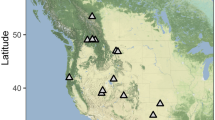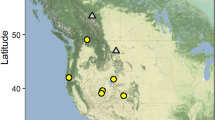Abstract
The maintenance of water balance in arid environments might represent a formidable challenge for Chiroptera, since they have high surface-to-volume ratios. In deserts, bats conserve water, for example, using daily torpor, but they also might experience episodic heat bouts, when they may need to increase total evaporative water loss (TEWL) to thermoregulate. We hypothesized that in bats, habitat aridity and its variability determine a trade-off between water conservation and thermoregulation via evaporative means. To test this hypothesis, we collated data from the literature of 22 species of bats on TEWL, body temperature and resting metabolic rate, in torpor and euthermy. We also collected data on ambient temperature (Ta) and precipitation of the locations where bats were captured, calculated an aridity index, and built an index of variability of the environment. After correcting for phylogeny, we found that, as aridity and variability of the environment increased, bats had lower values of TEWL, but the rate at which TEWL increases with Ta was higher, supporting our hypothesis. These results suggest that at high Ta there is a trade-off between water conservation and evaporative heat loss in bats. The evolution of physiological mechanisms that allow water conservation and tolerance to conditions of high Ta without access to free water might thus be crucial to explain the distribution of desert bats.


Similar content being viewed by others
References
Agnarsson I, Zambrana-Torrelio CM, Flores-Saldana NP, May-Collado LJ (2011) A time-calibrated species-level phylogeny of bats (Chiroptera, Mammalia). PLoS Curr 3:RRN1212
Albright TP, Mutiibwa D, Gerson AR, Smith EK, Talbot WA, O’Neill JJ, McKechnie AE, Wolf BO (2017) Mapping evaporative water loss in desert passerines reveals an expanding threat of lethal dehydration. Proc Natl Acad Sci USA 114:2283–2288
Almeida FC, Giannini NP, DeSalle R, Simmons NB (2011) Evolutionary relationships of the old world fruit bats (Chiroptera, Pteropodidae): another star phylogeny? BMC Evol Biol 11:281
Arad Z, Korine C (1993) Effect of water restriction on energy and water balance and osmoregulation of the fruit bat Rousettus aegyptiacus. J Comp Physiol B 163:401–405
Ben-Hamo M, Muñoz-Garcia A, Williams JB, Korine C, Pinshow B (2013) Waking to drink: rates of evaporative water loss determine arousal frequency in hibernating bats. J Exp Biol 216:573–577
Ben-Hamo M, Muñoz-Garcia A, Larrain AP, Pinshow B, Korine C, Williams JB (2016) The cutaneous lipid composition of bat wing and tail membranes: a case of convergent evolution with birds. Proc R Soc B 283:20160636
Bronner GN, Maloney SK, Buffenstein R (1999) Survival tactics within thermally challenging roosts: heat tolerance and cold sensitivity in the Angolan free-tailed bat, Mops condylurus. S Afr J Zool 34:1–10
Calder WA (1984) Size, function and life-history. Harvard University Press, Cambridge
Champagne AM, Allen HC, Bautista-Jimenez RC, Williams JB (2016) Organization of lipids in avian stratum corneum: changes with temperature and hydration. Chem Phys Lipids 195:47–57
Cockley AR, Champagne AM, Ben-Hamo M, Pinshow B, Williams JB, Korine C, Muñoz-Garcia A (2021) Lipid composition of the stratum corneum in different regions of the body in the Pipistrelle’s bat, Pipistrellus kuhlii, from the Negev Desert. Israel. Comp Biochem Phys A 262:111074
Cory-Toussaint D, McKechnie AE (2012) Interspecific variation in thermoregulation among three sympatric bats inhabiting a hot, semi-arid environment. J Comp Physiol B 182:1129–1140
Cryan PM, Wolf BO (2003) Sex differences in the thermoregulation and evaporative water loss of a heterothermic bat, Lasiurus cinereus, during its spring migration. J Exp Biol 206:3381–3390
Czenze ZJ, Naidoo S, Kotze A, McKechnie AE (2020) Bat thermoregulation in the heat: limits to evaporative cooling capacity in three southern African bats. J Therm Biol 89:102542
Damien F, Boncheva M (2010) The extent of orthorhombic lipid phases in the stratum corneum determines the barrier efficiency of human skin in vivo. J Invest Dermatol 130:611–614
Emberger L (1955) Afrique du Nord-Ouest. In: UNESCO (ed) Plant Ecology: reviews of research. UNESCO, Paris, pp 219–249
Flores-Abreu IN, Trejo-Salazar RE, Sánchez-Reyes LL, Good SV, Magallón S, García-Mendoza A, Eguiarte LE (2019) Tempo and mode in coevolution of Agave sensu lato (Agavoideae, Asparagaceae) and its bat pollinators, Glossophaginae (Phyllostomidae). Mol Phylogenet Evol 133:176–188
Gearhart C, Adams AM, Pinshow B, Korine C (2019) Evaporative water loss in Kuhl’s pipistrelles declines along an environmental gradient, from mesic to hyperarid. Comp Biochem Physiol A. https://doi.org/10.1016/j.cbpa.2019.110587
Geiser F (2004) Metabolic rate and body temperature reduction during hibernation and daily torpor. Ann Rev Physiol 66:239–274
Geiser F, Stawski C (2011) Hibernation and torpor in tropical and subtropical bats in relation to energetics, extinctions, and the evolution of endothermy. Integr Comp Biol 51:337–348
Gharaibeh BM, Qumsiyeh MB (1995) Otonycteris Hemprichii. Mamm Species 514:1–4
Henderson-Sellers B (1984) A new formula for latent heat of vaporization of water as a function of temperature. Q J R Meteor Soc 110:1186–1190
Herreid CF (1967) Temperature regulation, temperature preference and tolerance, and metabolism of young and adult free-tailed bats. Physiol Zool 40:1–22
Hosken DJ, Withers PC (1999) Metabolic physiology of euthermic and torpid lesser long-eared bats, Nyctophilus geoffroyi (Chiroptera: Vespertilionidae). J Mammal 80:42–52
Jones KE, Bininda-Emonds OR, Gittleman JL (2005) Bats, clocks, and rocks: diversification patterns in Chiroptera. Evolution 59:2243–2255
Korine C, Daniel S, Pinshow B (2013) Roost selection by females Hemprich’s long-eared bat. Behav Process 100:131–138
Korine C, Adams R, Russo D, Fisher-Phelps M, Jacobs D (2016) Bats and water: anthropogenic alterations threaten global bat populations. In: Voigt CC, Kingston T (eds) Bats in the Anthropocene: conservation of bats in a changing world. Springer, Cham, pp 215–233
Kunz TH, Hood WR (2000) Parental care and postnatal growth. In: Crichton EG, Krutzsch PHE (eds) Reproductive biology of bats. Academic Press, London, pp 415–468
Lack JB, Van Den Bussche RA (2010) Identifying the confounding factors in resolving phylogenetic relationships in Vespertilionidae. J Mammal 91:1435–1448
Lamb JM, Ralph T, Naidoo T, Taylor PJ, Ratrimomanarivo F, Stanley WT, Goodman SM (2011) Toward a molecular phylogeny for the Molossidae (Chiroptera) of the Afro-Malagasy region. Acta Chiropterol 13:1–16
Licht P, Leitner P (1967) Behavioral responses to high temperatures in three species of California bats. J Mammal 48:52–61
Lillywhite HB (2006) Water relations of tetrapod integument. J Exp Biol 209:202–226
Lovegrove BG (2000) The zoogeography of mammalian basal metabolic rate. Am Nat 156:201–219
Lovegrove BG (2003) The influence of climate on the basal metabolic rate of small mammals: a slow-fast metabolic continuum. J Comp Physiol B 173:87–112
Maloney SK, Bronner GN, Buffenstein R (1999) Thermoregulation in the Angolan free-tailed bat Mops condylurus: a small mammal that uses hot roosts. Physiol Biochem Zool 72:385–396
Marder J, Ben-Asher J (1983) Cutaneous water evaporation—I. Its significance in heat-stressed birds. Comp Biochem Physiol A 75:425–431
Marom S, Korine C, Wojciechowski MS, Tracy CR, Pinshow B (2006) Energy metabolism and evaporative water loss in the European free-tailed bat and Hemprich’s long-eared bat (Microchiroptera), species sympatric in the Negev desert. Physiol Biochem Zool 79:944–956
McKechnie AE, Wolf BO (2019) The physiology of heat tolerance in small endotherms. Physiol 34:302–313
McKechnie AE, Whitfield MC, Smit B, Gerson AR, Smith EK, Talbot WA, McWhorter TJ, Wolf BO (2016) Avian thermoregulation in the heat: efficient evaporative cooling allows for extreme heat tolerance in four southern hemisphere columbids. J Exp Biol 219:2145–2155
McNab BK (2002) The physiological ecology of vertebrates: a view from energetics. Cornell University Press
Menzies AK, Webber QM, Baloun DE, McGuire LP, Muise KA, Coté D, Tinkler S, Willis CK (2016) Metabolic rate, latitude and thermal stability of roosts, but not phylogeny, affect rewarming rates of bats. Physiol Behav 164:361–368
Minnaar IA, Bennett NC, Chimimba CT, McKechnie AE (2014) Partitioning of evaporative water loss into respiratory and cutaneous pathways in Wahlberg’s epauletted fruit bats (Epomophorus wahlbergi). Physiol Biochem Zool 87:475–485
Mitchell D, Snelling EP, Hetem RS, Maloney SK, Strauss WM, Fuller A (2018) Revisiting concepts of thermal physiology: predicting responses of mammals to climate change. J Anim Ecol 87:956–973
Muñoz-Garcia A, Ro J, Brown JC, Williams JB (2008) Cutaneous water loss and sphingolipids in the stratum corneum of house sparrows, Passer domesticus L., from desert and mesic environments as determined by reversed phase high-performance liquid chromatography coupled with atmospheric pressure photospray ionization mass spectrometry. J Exp Biol 211:447–458
Muñoz-Garcia A, Larraín P, Ben-Hamo M, Cruz-Neto A, Williams JB, Pinshow B, Korine C (2016) Metabolic rate, evaporative water loss and thermoregulatory state in four species of bats in the Negev desert. Comp Biochem Physiol A 191:156–165
Nowak RM, Walker EP (1994) Walker’s bats of the world. JHU
Noy-Meir I (1973) Desert ecosystems: environment and producers. Ann Rev Ecol Syst 4:25–41
Oftedal OT (1984) Milk composition, milk yield and energy output at peak lactation: a comparative review. Symp Zool Soc Lond 51:33–85
Paradis E, Claude J, Strimmer K (2004) APE: analyses of phylogenetics and evolution in R language. Bioinformatics 20:289–290
Patrick LE, Stevens RD (2016) Phylogenetic community structure of North American desert bats: Influence of environment at multiple spatial and taxonomic scales. J Anim Ecol 85:1118–1130
Phillips WR (1984) Seasonal adaptation in Gould's long-eared bat; Nyctophilus gouldi Tomes 1858 (Microchiroptera: Vespertilionidae). PhD diss. Australian National University Canberra, Australia
Razgour O, Persey M, Shamir U, Korine C (2018) The role of climate, water and biotic interactions in shaping biodiversity patterns in arid environments across spatial scales. Divers Distrib 24:1440–1452
Ruf T, Geiser F (2015) Daily torpor and hibernation in birds and mammals. Biol Rev 90:891–926
Schmidt-Nielsen K (1997) Animal physiology: adaptation and environment. Cambridge University Press, Cambridge
Speakman JR, Thomas DW (2003) Physiological ecology and energetics of bats. In: Kunz TH, Fenton MB (eds) Bat ecology. The University of Chicago Press, Chicago, pp 390–430
Stawski C, Willis CKR, Geiser F (2014) The importance of temporal heterothermy in bats. J Zool 292:86–100
Studier EH (1970) Evaporative water loss in bats. Comp Biochem Physiol A 35:935–943
Thomas DW, Cloutier D (1992) Evaporative water loss by hibernating little brown bats, Myotis lucifugus. Physiol Zool 65:443–456
Van Sant MJ, Oufiero CE, Muñoz-Garcia A, Hammond KA, Williams JB (2012) A phylogenetic comparison of total evaporative water loss in mammals. Physiol Biochem Zool 85:526–532
Webb PI (1995) The comparative ecophysiology of water balance in microchiropteran bats. Symp Zool Soc Lond 67:203–218
Williams JB (1996) A phylogenetic perspective of evaporative water loss in birds. Auk 113:457–472
Williams JB, Tieleman BI (2005) Physiological adaptation in desert birds. Bioscience 55:416–426
Williams JB, Muñoz-Garcia A, Ostrowski S, Tieleman BI (2004) A phylogenetic analysis of basal metabolism, total evaporative water loss, and life-history among foxes from desert and mesic regions. J Comp Physiol B 174:29–39
Withers PC, Cooper CE, Larcombe AN (2006) Environmental correlates of physiological variables in marsupials. Physiol Biochem Zool 79:437–453
Wolf B, Walsberg G (1996) Respiratory and cutaneous evaporative water loss at high environmental temperatures in a small bird. J Exp Biol 199:451–457
Acknowledgements
We thank Catalina Manrique-Correa for her invaluable help with data collection and analyses. We also thank Prof. Berry Pinshow and several anonymous reviewers for useful comments in the preparation of the manuscript. This is paper number 1110 of the Mitrani Department of Desert Ecology.
Funding
This research was supported by grant number 2008469 of the US-Israel Binational National Science Foundation to CK and JBW, and a Blaustein Postdoctoral Fellowship and a VATAT fellowship from the Council of Higher Education, awarded to AMG.
Author information
Authors and Affiliations
Contributions
AMG and JBW conceived the project, all authors have participated in data collection, AMG and KC designed the analysis, AMG did the analysis and prepared the figures. AMG and KC wrote the manuscript. All authors contributed with critical feedback on several revisions of the manuscript.
Corresponding author
Ethics declarations
Conflict of interest
The authors report no conflict of interest.
Additional information
Communicated by Philip Withers.
Publisher's Note
Springer Nature remains neutral with regard to jurisdictional claims in published maps and institutional affiliations.
Supplementary Information
Below is the link to the electronic supplementary material.
Rights and permissions
About this article
Cite this article
Muñoz-Garcia, A., Ben-Hamo, M., Pilosof, S. et al. Habitat aridity as a determinant of the trade-off between water conservation and evaporative heat loss in bats. J Comp Physiol B 192, 325–333 (2022). https://doi.org/10.1007/s00360-021-01425-2
Received:
Revised:
Accepted:
Published:
Issue Date:
DOI: https://doi.org/10.1007/s00360-021-01425-2




